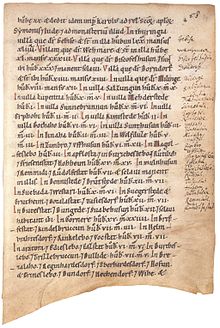Breviary sancti Lulli
The Breviarium sancti Lulli or Brevarium Lulli for short is a list of goods belonging to the Hersfeld Monastery . It contains the property that the monastery received at the time of the monastery founder and Archbishop of Mainz , Lullus .
The list of goods has been handed down in a copy that was re-edited from the end of the 9th century on the source. It can be found in the oldest Hersfeld copy book liber de libertatibus locorum Hersfeldensium from the 12th century on pages fol. 33 v - 35 v . The copy book was written around 1150 and is only preserved today in fragments. In addition to the list of goods, the copy book also contains other copies of documents from the popes and kings. It was written on parchment in Gothic minuscule and is 25.3 × 16.3 cm. The binding from the 15th century is made with leather binding over wooden covers. The leather strap is provided with rich blind embossing .
The directory begins on fol. 33 v with the sentence:
“Incipit Breviarium sancti Lvlli archiepiscopi. Breve com (pendium) de illis rebus, quẹ pertinent ad monasterium quod dicitur Herolfesfeld, quod construxit sanctus Lvllvs archiepiscopus Mog (untinus) in marca Hassorum in Bůchonia in ripa fluminis Fulda et tradidit domno imperatori Karolo. "
Then the list of goods is divided into three main sections, the so-called tables. The first panel contains the donations of Charlemagne up to the death of Lullus in the year 786. Individual additions are probably from the years 802 and 814. The second panel contains acquisitions by Lullus and gifts from free persons up to the handover of the monastery to King Charles in the year 775. Some additions were made until Lullus' death in 786. It is therefore assumed that this property was given to the monastery between 755 and 786. The third panel finally contains donations made by free people after the monastery was handed over to Emperor Karl. This means that donations that took place from 775 onwards are notarized here. The chronological end of this table and the entire directory is believed to have been in the period from 802 to before 815 (documents that were evidently issued from 815 onwards are no longer included in the directory), the end of the reign of Emperor Karl.
The locations are sorted geographically within the tables. The property in Hersfeld is mentioned first in the first and second panels. Most of the places were then in Thuringia , which are mentioned most in the first and second panels. This is followed by places in the Wetterau and Wormsgau on the first panel . The second panel shows places in Lahngau and Hessengau . The initials and the first letters of the names are written in red ink or are highlighted with red dots or lines. The property in the individual places is named in Hufen and Mansen and these measurements are summed up at the end of the individual tables. Finally, at the end of the list on panel 3, there is the total number of hooves and manes and the number of monks in the monastery.
“Continentur enim in summa hůb (ę) ML et mansus DCCXCV. Numerus fratrum est CL. "
“That gives a total of 1050 hooves and 795 men. The number of brothers is 150 "
The sum of the hooves and manes, however, is incorrect both in the tables and at the end. The reason for this could be the addenda made at the end of the 9th century. What exactly was understood by the dimensions of hoof and manse at the time, or what the difference was, is not clearly verifiable. Furthermore, the term “villa” is ambiguous in Latin. Both the manorial farm and a rural village can be meant here.
Many localities in Thuringia , Saxony-Anhalt and Hesse , such as Kölleda , Kirchscheidungen or Borken and today's district of Borken, Großenenglis, were first mentioned here in documents. The Breviarium Sancti Lulli is so together with the summaries of the Codex Eberhardi for Hesse and Thuringia one of the main sources of the Carolingian period . The breviary is in today State Archives Marburg kept.
literature
- Thomas Franke (Ed.): Breviarium sancti Lulli . A Hersfeld list of goods from the 9th century. Facsimile edition. Self-published in the district of Hersfeld-Rothenburg, Bad Hersfeld 1986 (facsimile and transcription).
- Josef Hörle: Breviarium sancti Lulli - shape and content . In: Archive for Middle Rhine Church History . tape 12 . Verlag der Jägerschen Buchdruckerei, Speyer am Rhein 1960, p. 18-52 .
- Hans Weirich, Karl Hörges: Document book of the Reichsabtei Hersfeld . In: Publication of the historical commission for Hesse and Waldeck . XIX, volume 1 . Commission publishing house of NG Elwertschen Buchhandlung, Marburg 1936, p. 68-74 .
- Georg Landau : Breuiarium sancti Lvlli archiepiscopi . In: Journal of the Association for Hessian History and Regional Studies . tape 10 , 1865, p. 184–192 ( limited preview in Google Book search).
References and comments
- ^ Walter Schlesinger, preliminary studies for an investigation on the hooves in Selected essays by Walter Schlesinger 1965-1979 (lectures and research 34), Sigmaringen 1987, p. 485
- ↑ Thomas Franke, Breviarium sancti Lulli, page 10
Web links
- Description and illustration at DigAM digital archive in Marburg
